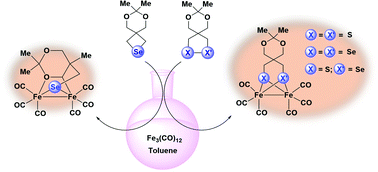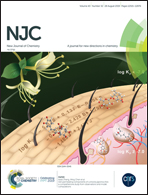Sulphur–sulphur, sulphur–selenium, selenium–selenium and selenium–carbon bond activation using Fe3(CO)12: an unexpected formation of an Fe2(CO)6 complex containing a μ2,κ3-C,O,Se-ligand†
Abstract
Three diiron hexacarbonyl complexes containing dithiolato (5), diselenolato (6), and selenolato-thiolato ligands (7), respectively, have been prepared as [FeFe]-hydrogenase mimics. Treatment of Fe3(CO)12 with one equivalent of the corresponding 5-membered heterocycles 1, 3 and 4 in toluene at reflux afforded the corresponding complexes 5–7. The reaction of 5,5-bis(bromomethyl)-2,2-dimethyl-1,3-dioxane with in situ generated Na2Se2 results in the formation of 8,8-dimethyl-7,9-dioxa-2,3-diselenaspiro[4.5]decane (1) and traces of 7,7-dimethyl-6,8-dioxa-2-selenaspiro[3.4]nonane (2). Alternatively, 5,5-bis(bromomethyl)-2,2-dimethyl-1,3-dioxane reacts with in situ generated Na2Se yielding compound 2 in 26% yield. When Fe3(CO)12 reacts under reflux with the selenaspiro compound 2 in toluene, the unique diiron complex, [Fe2(CO)6{μ2,κ3-Se,C,O-SeCH2C7H12O2}] (8), is obtained as a result of an initial selenium–carbon bond activation. Compounds 5, 6, 7, and 8 were characterized by IR, 1H, 13C{1H}, and 77Se{1H} NMR spectroscopy, mass spectrometry, elemental analysis, and X-ray single-crystal structure analysis. The chiral complex 8 shows a coordination of the O atom at the dioxane ring to one Fe atom and the O–CH− carbanionic group to the other Fe atom. Furthermore, we investigated the redox properties and the catalytic behaviour of complexes 5–8 in the presence of AcOH as a source of protons. The reduction of complexes 5–7 is accompanied by a chemical process resulting in an overall two-electron transfer at their primary reduction wave. This observation is consistent with an ECE reduction (E = electrochemical process, C = chemical process), while each reduction event in the case of complex 8 involves simple transfer of one electron. Moreover, high level DFT calculations were performed on neutral 8 and its reduction products 8− and 82−.

- This article is part of the themed collection: Selenium & Tellurium chemistry at the beginning of the 3rd millennium: a celebration of ICCST


 Please wait while we load your content...
Please wait while we load your content...